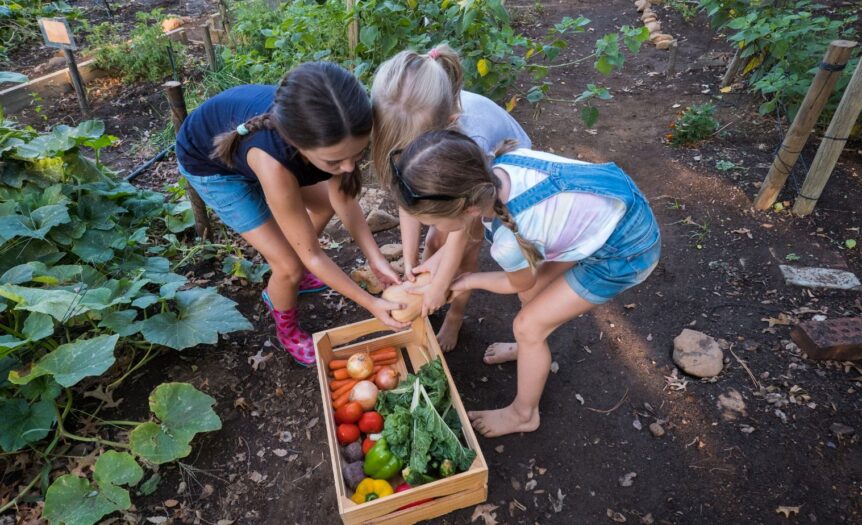While a sprawling backyard might give you the freedom to experiment widely, a compact garden space requires strategic planning and smart design choices to optimize yield. Creative solutions such as vertical planting, companion planting, and succession planting are just a few ways to make the most of limited square footage. Whether it’s trellising climbers or planting herbs in the gaps between lettuce, utilizing every inch effectively is key to a bountiful small-scale vegetable garden.
It’s a good thing that Narellan Sand is always available to provide you with high-quality soil for your vegetable garden.
Below are the top 10 strategies for maximizing your harvest in a small-scale vegetable garden:
Elevate Your Garden with Companion Planting
In the world of small-scale gardening, companion planting is akin to a well-choreographed dance, where each plant complements the other to enhance growth, deter pests, and boost overall yield. For instance, take the dynamic duo of carrots and radishes—while the radishes germinate quickly, they make way for the slower-growing carrots, optimizing the use of space and timing. Tall tomato plants, too, serve as benevolent giants providing shade and support, allowing lower-growing herbs like basil to thrive in their shelter.
Try these successful pairings to get the most out of every garden inch:
- Carrots: Flourish alongside beans, peas, tomatoes, onions, and lettuce.
- Corn: Thrives with squash, potatoes, peas, melons, and cucumbers for a diverse harvest.
- Onions: Grow well in the company of lettuce, carrots, and beets.
- Garlic: Pairs perfectly with beets, carrots, radishes, and leafy greens such as spinach.
- Tomatoes: I love the companionship of basil, which is said to improve their flavor, as well as being a good neighbor to squash, cucumbers, and carrots.
- Peppers: Benefit from the proximity of basil and onions, enhancing flavor and health.
- Zucchini: Prospers, when planted with peas, beans, radishes, and corn, give a veritable feast for the eyes and plate.
For detailed guides on nurturing each of these companions, simply click on their names and watch your garden—and your table—bloom with variety.
Go Vertical: The Sky’s the Limit in Small-Space Gardens
Embrace the upward climb with vertical planting—ideal for vining vegetables such as cucumbers and squashes. By implementing trellises, arches, or even repurposed fencing, you create a living green wall that not only saves valuable ground space but also adds an aesthetic dimension to your garden.
Training these climbers skywards allows for improved air circulation and sunlight exposure, resulting in healthier plants and a more abundant harvest. With the underside of your canopy free, consider planting shade-tolerant species to enhance your garden’s diversity, beauty, and yield.
Create a Haven for Helpful Wildlife
Inviting wildlife into your garden not only enriches the ambiance with melodic birdsong but also integrates natural pest control. By incorporating leafy trees and dense shrubs, you provide essential shade and safe havens for these beneficial creatures. Ensuring bird feeders are squirrel-proof keeps seeds available for their intended avian guests.
Such additions encourage a thriving ecosystem where pollinators flourish, pests are managed, and the natural cycle of growth is supported, ultimately leading to a more resilient and productive garden.
Cultivate the Uncommon to Reap Exclusive Rewards
In the economy of space, consider sowing seeds of rarity—vegetables and herbs not readily found on your local grocery shelves. This strategy transforms your garden into a sanctuary of unique flavors and uncommon harvests. Evaluate what culinary delights you often find yourself hunting for and set aside a plot to cultivate these treasures.

Prioritise plants based on their scarcity and personal value, be they exotic herbs, heirloom vegetables, or ethnic specialties, and relish the satisfaction of a garden that caters to your bespoke tastes.
Opt for Space-Efficient Varieties
When selecting plants for your compact garden, it’s important to look for varieties that utilize space efficiently. Unlike the sprawling nature of bushier plants like cabbages and broccoli, certain vegetables—such as carrots, onions, and radishes—occupy less room, making them prime choices for space-conscious gardeners. Plant these compact growers closely; as you harvest the early bloomers, it naturally thins the crop. This strategic thinning grants the remaining plants ample space to flourish.
Additionally, embrace the potential of dwarf varieties, such as miniature cucumbers or baby-leaf lettuce. These pint-sized plants provide high yields in small spaces and can easily tuck into the tiniest of gardening gaps, ensuring no square inch goes to waste.
Start Seedlings Indoors: An Early Boost for Your Garden
Maximize your growing season by beginning with indoor seedlings. This approach not only gives you a head start but also ensures better survival rates as young plants are protected from harsh outdoor elements. While nurturing these seedlings, prep your outdoor beds by enriching the soil with well-rotted compost or manure, setting the stage for robust growth once transplanted.
Alternatively, selecting seedlings from reputable nurseries can provide a convenient yet effective route to cultivating a lush garden. Ideal candidates for early indoor planting include Brussels sprouts, peppers, celery, cauliflower, cabbage, and broccoli, each promising a rewarding harvest for your culinary exploration.
Utilise Railings as Elevated Garden Beds
Leveraging the unused space of your deck or balcony railings can dramatically increase your gardening area. Custom-built or ready-made planter boxes can be securely mounted on railings, providing a creative and elevated solution for tight spaces. Before installation, ensure that the railings can support the weight of the soil, water, and plant life.
It’s essential that these boxes have sufficient depth to accommodate the plants chosen, particularly for those vegetables with extensive root systems. This approach not only adds dimension to your garden but also brings your crops closer to eye level for easier maintenance and enjoyment.
Prioritise High-Yield Crops for Maximum Efficiency
In the quest to maximize your garden’s productivity, prioritizing high-yield crops becomes a game-changer. Lettuce, kale, chard, and radishes not only promise quick harvest cycles but also offer the satisfaction of a constant supply.
With a strategic approach to succession planting—sowing a new row every few weeks—you ensure a seamless and abundant output throughout the gardening season. This method is the secret sauce to small garden success, allowing you to reap a bountiful and diverse harvest from just a few square feet.
Harness the Versatility of Pots and Containers
In the art of small-space gardening, pots, and containers stand out as versatile heroes. Easily nestled against a sunlit fence or arranged on a welcoming patio, they become pivotal in growing an array of herbs and compact crops. For those with a flair for tomatoes, cherry varieties thrive in large pots, basking on a sheltered deck, offering a cascade of sweet fruit.

Equally functional are grown bags, which conform to the smallest of urban spaces—even a cozy apartment balcony—providing valuable square footage for your green aspirations. Embracing container gardening not only expands your planting real estate but also introduces mobility and modularity to your gardening strategy.
Elevate Your Harvest with Raised Garden Beds
Maximizing space and yield in your compact garden can be efficiently achieved through the strategic use of raised beds. By design, raised beds mitigate space constraints, as plants can drape gracefully over the edges without being constricted, continuing their growth and productivity. This method can significantly increase your crops per square foot.
Craft these elevated plots with natural timber or durable steel for longevity and sustainability—steering clear of pressure-treated lumber to prevent chemical leaching into your precious edibles. Raised beds not only optimize your growing area but also contribute to a more manageable and aesthetically pleasing garden experience.






